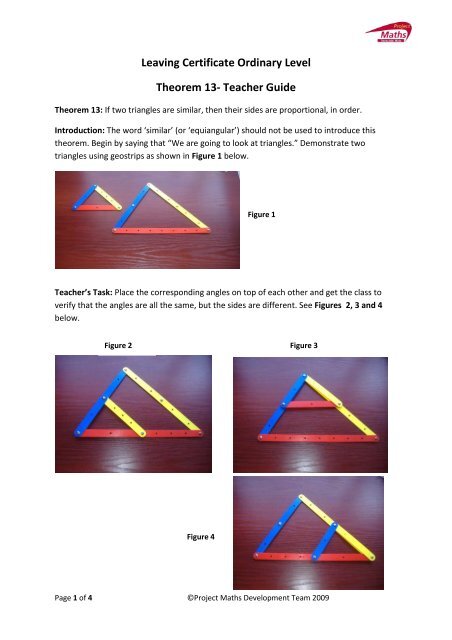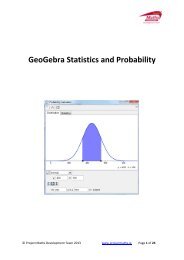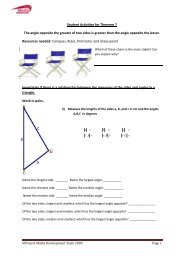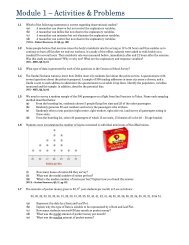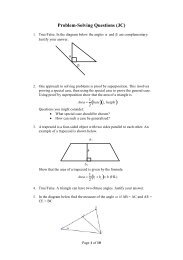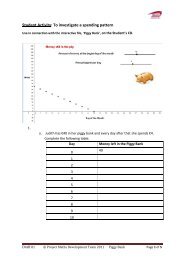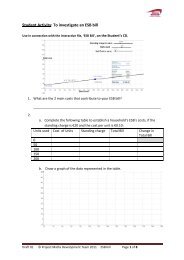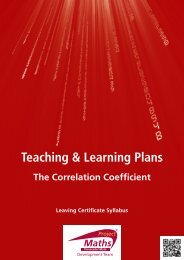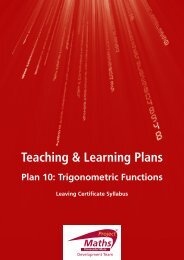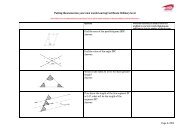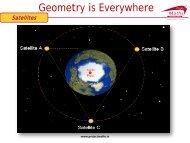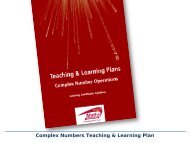Leaving Certificate Ordinary Level Theorem 13 ... - Project Maths
Leaving Certificate Ordinary Level Theorem 13 ... - Project Maths
Leaving Certificate Ordinary Level Theorem 13 ... - Project Maths
Create successful ePaper yourself
Turn your PDF publications into a flip-book with our unique Google optimized e-Paper software.
<strong>Leaving</strong> <strong>Certificate</strong> <strong>Ordinary</strong> <strong>Level</strong><strong>Theorem</strong> <strong>13</strong>- Teacher Guide<strong>Theorem</strong> <strong>13</strong>: If two triangles are similar, then their sides are proportional, in order.Introduction: The word ‘similar’ (or ‘equiangular’) should not be used to introduce thistheorem. Begin by saying that “We are going to look at triangles.” Demonstrate twotriangles using geostrips as shown in Figure 1 below.Figure 1Teacher’s Task: Place the corresponding angles on top of each other and get the class toverify that the angles are all the same, but the sides are different. See Figures 2, 3 and 4below.Figure 2Figure 3Figure 4Page 1 of 4 ©<strong>Project</strong> <strong>Maths</strong> Development Team 2009
Establish the common properties of these triangles and establish the differences (sides). Atthis stage the word ‘similar’ may be used to relate to the two triangles.Draw attention to the colour coding of the sides. This can be used to identify pairs ofcorresponding sides. i.e. The large yellow side corresponds to the small yellow side etcPupils’ Task 1: Using various sizes of geostrips get pupils to make up a pair of similartriangles and verify as above.Figure 5At this stage some pupils may not be able to create pairs of similar triangles. This is fine andshould be used by the teacher to differentiate between triangles which are similar andthose which are not.Page 2 of 4 ©<strong>Project</strong> <strong>Maths</strong> Development Team 2009
Pupils’ Task 2: Get class to construct the following triangle ABC, where |AB| = somedistance between 4cm and 9cm. Make it a whole number.|∠CAB| = 50° and |∠ABC| = 70°.Then get class to construct the triangle DEF, where |DE| = 1½ times the distance ,|∠FDE| = 50° and |∠DEF| = 70°.1. The pupils should measure |∠ACB| and |∠DFE| to verify that they have indeedconstructed similar triangles2. Get the class to measure and calculate each of the following:| DF | | EF | | AB |( i) (ii) (iii)| AC | | BC | | DE |3. What do you notice ?Pupils’ Task 3: Teacher to measure the length of the blue, yellow and red sides on each ofthe triangles used during the teacher’s task and investigate if the sides are in ratio.Pupils’ Task 4: Introduce the idea of a ‘converse’Statement True/False Converse True/FalseIf I have visited Rome then I havebeen to Italy.A square is a quadrilateral with 4sides.If an angle is less than 90 0 it is anacute angle.If 3 points are not collinear, thenthey can be joined to make atriangle.If a quadrilateral has 4 right anglesthen it is a rectangle.If two triangles are similar, thentheir sides are proportional, inorder.Page 3 of 4 ©<strong>Project</strong> <strong>Maths</strong> Development Team 2009
Pupils’ Task 5: Then test the converse of theorem <strong>13</strong>.1. Get pupils to construct two triangles whose sides are in ratio. E.g. small triangle withsides 6cm, 9cm and 12cm. Larger triangle with sides 8cm, 12cm and 16cm.2. Using a protractor verify that the two triangles are similar.3. Ask pupils to construct two more triangles which whose sides are in ratio. Suggest aratio of 1: 1¼ . Then check these triangles to see if they are similar.Teacher’s Task: Using the board, link similar triangles to enlargementsEmphasise the idea that there is an infinite number of similar triangles possible using this method.Pupils’ Task 6: The ‘Guidelines for Teachers’ (shown on the right) has ashort lesson idea, which illustrates the differences between similartriangles and congruent triangles.The lesson is titled “SIMILARITY V CONGRUENCE AND RATIO”and is “Geometry Lesson Idea 12” in the Guidelines.Page 4 of 4 ©<strong>Project</strong> <strong>Maths</strong> Development Team 2009


